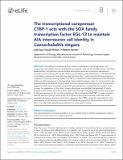| dc.contributor.author | Saul, Josh | |
| dc.contributor.author | Hirose, Takashi | |
| dc.contributor.author | Horvitz, H Robert | |
| dc.date.accessioned | 2022-12-08T19:41:46Z | |
| dc.date.available | 2022-12-08T19:41:46Z | |
| dc.date.issued | 2022 | |
| dc.identifier.uri | https://hdl.handle.net/1721.1/146808 | |
| dc.description.abstract | <jats:p>Cell identity is characterized by a distinct combination of gene expression, cell morphology, and cellular function established as progenitor cells divide and differentiate. Following establishment, cell identities can be unstable and require active and continuous maintenance throughout the remaining life of a cell. Mechanisms underlying the maintenance of cell identities are incompletely understood. Here, we show that the gene <jats:italic>ctbp-1,</jats:italic> which encodes the transcriptional corepressor <jats:italic>C-t</jats:italic>erminal <jats:italic>b</jats:italic>inding <jats:italic>p</jats:italic>rotein-1 (CTBP-1), is essential for the maintenance of the identities of the two AIA interneurons in the nematode <jats:italic>Caenorhabditis elegans. ctbp-1</jats:italic> is not required for the establishment of the AIA cell fate but rather functions cell-autonomously and can act in later larval stage and adult worms to maintain proper AIA gene expression, morphology and function. From a screen for suppressors of the <jats:italic>ctbp-1</jats:italic> mutant phenotype, we identified the gene <jats:italic>egl-13,</jats:italic> which encodes a SOX family transcription factor. We found that <jats:italic>egl-13</jats:italic> regulates AIA function and aspects of AIA gene expression, but not AIA morphology. We conclude that the CTBP-1 protein maintains AIA cell identity in part by utilizing EGL-13 to repress transcriptional activity in the AIAs. More generally, we propose that transcriptional corepressors like CTBP-1 might be critical factors in the maintenance of cell identities, harnessing the DNA-binding specificity of transcription factors like EGL-13 to selectively regulate gene expression in a cell-specific manner.</jats:p> | en_US |
| dc.language.iso | en | |
| dc.publisher | eLife Sciences Publications, Ltd | en_US |
| dc.relation.isversionof | 10.7554/ELIFE.74557 | en_US |
| dc.rights | Creative Commons Attribution 4.0 International license | en_US |
| dc.rights.uri | https://creativecommons.org/licenses/by/4.0/ | en_US |
| dc.source | eLife | en_US |
| dc.title | The transcriptional corepressor CTBP-1 acts with the SOX family transcription factor EGL-13 to maintain AIA interneuron cell identity in Caenorhabditis elegans | en_US |
| dc.type | Article | en_US |
| dc.identifier.citation | Saul, Josh, Hirose, Takashi and Horvitz, H Robert. 2022. "The transcriptional corepressor CTBP-1 acts with the SOX family transcription factor EGL-13 to maintain AIA interneuron cell identity in Caenorhabditis elegans." eLife, 11. | |
| dc.contributor.department | Massachusetts Institute of Technology. Department of Biology | en_US |
| dc.relation.journal | eLife | en_US |
| dc.eprint.version | Final published version | en_US |
| dc.type.uri | http://purl.org/eprint/type/JournalArticle | en_US |
| eprint.status | http://purl.org/eprint/status/PeerReviewed | en_US |
| dc.date.updated | 2022-12-08T18:41:15Z | |
| dspace.orderedauthors | Saul, J; Hirose, T; Horvitz, HR | en_US |
| dspace.date.submission | 2022-12-08T18:41:18Z | |
| mit.journal.volume | 11 | en_US |
| mit.license | PUBLISHER_CC | |
| mit.metadata.status | Authority Work and Publication Information Needed | en_US |
